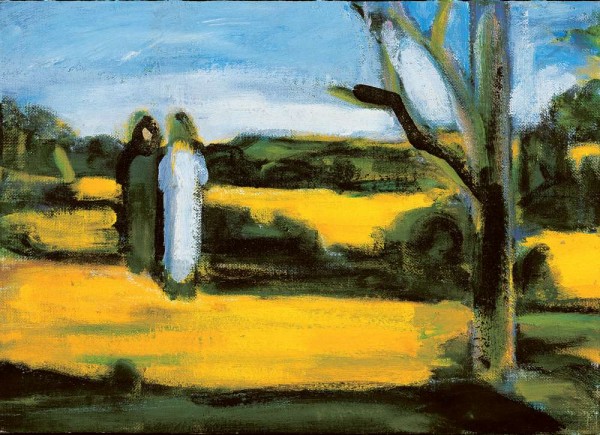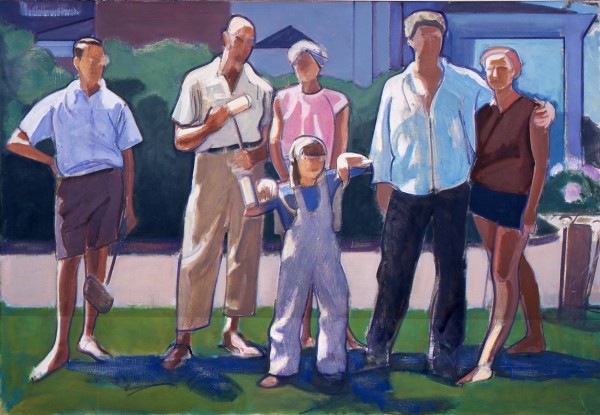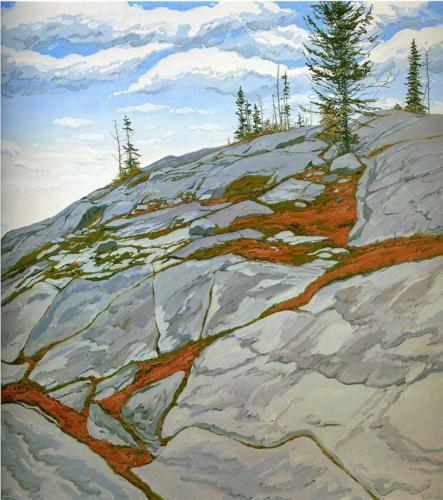
Albert Kresch, “Conversation,” oil on panel, 1994 (Collection of the Center for Figurative Painting, New York)
National Academy Museum
1083 Fifth Ave. at 89th St.
Through Sunday, January 26, $15, 11:00 am – 6:00 pm
212-369-4880
www.nationalacademy.org
“You can’t escape your time,” Paul Resilka says in a promotional video for the National Academy exhibit “See It Loud: Seven Post-War American Painters,” continuing, “Some embrace it. Some fight it. As for myself, I suppose I had a contrarian streak in me.” The show, hung throughout the entire museum, consists of nearly eighty landscapes, portraits, still-lifes, and other paintings by Leland Bell (1922-91), Paul Georges (1923-2002), Neil Welliver (1929-2005), Peter Heinemann (1931-2010), Albert Kresch (1922-), Stanley Lewis (1941-), and Resika (1928-), dating from 1963 to 2011. The seven men broke away from the Abstract expressionists and turned toward a more representational style, resulting is dazzling canvases with bold use of line and color, inspired by such artists as Hans Hoffmann, Piet Mondrian, Joan Miró, Jean Helion, and Pierre Bonnard. Eight works by Bell, who was married to fellow painter and National Academician Louisa Matthiasdottir, combine figuration and abstraction, particularly two versions of “Figure Group with Bird,” as geometric patterns give way to men, women, and animals. Paul Georges’s “The Mugging of the Muse,” a cartoonlike rendering of a street-corner attack, led to a libel suit brought by two men who believe they were the ones being maligned in the work; however, Georges’s “Artist in Studio” is a more impressive canvas, the artist standing defiant in the center, brush in his left hand, a seated nude in the right foreground. Ten self-portraits by a never-smiling Heinemann feature unique framing devices except for the final one, in which he wears sunglasses and a hat and is accompanied by a cat.

Leland Bell, “Croquet Party,” oil on canvas, 1965 (Collection of the Center for Figurative Painting, New York)
Welliver concentrates on rocky areas, woods, and winding rivers; his “Blueberries in Fissures” gives a dizzying sense of space. The baby of the group, Lewis incorporates his sculpture background into canvases rich with texture, in addition to several splendid drawings on paper. New York City native Resika’s peaceful works often include the moon and small houses in gorgeous coloration, while “Dark Lady” begs for meditative moments. But Kresch nearly steals the show with his mostly small, horizontal landscapes with glowing patches of sunlight and faceless figures; you can practically hear what the two women are saying to each other in “Conversation,” while “Landscape with House” couldn’t be more inviting. Painting, especially figurative, may have been declared dead many times during the twentieth century, but these seven men — several of whom are still at work in this new century — kept it alive with bold, daring works that knowingly spit in the face of the Abstract Expressionists.
